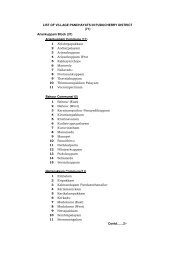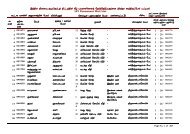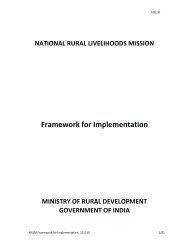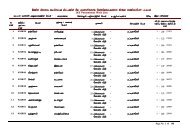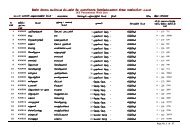FAQ - (DRDA), Puducherry
FAQ - (DRDA), Puducherry
FAQ - (DRDA), Puducherry
You also want an ePaper? Increase the reach of your titles
YUMPU automatically turns print PDFs into web optimized ePapers that Google loves.
Frequently Asked Questions (<strong>FAQ</strong>) on Swarnjayanti Gram Swarozgar Yojana<br />
(SGSY)<br />
1) What is the aim of the Swarnjayanti Gram Swarozgar Yojana<br />
• SGSY is a self-employment programme of Ministry of Rural Development that aims at<br />
providing assistance to the BPL rural poor for establishing micro-enterprises through<br />
bank credit and government subsidy to acquire an income-generating asset.<br />
• Self Help Groups (SHGs) are formed through a process of social mobilization,<br />
with their training and capacity building, infrastructure build up, technology, credit and<br />
marketing enabling them to take decisions on all issues concerning poverty eradication.<br />
2) How do I form a Self Help Group, or participate in one such group<br />
• Under SGSY, the individual beneficiaries and members of SHGs are called swarozgaris.<br />
• Generally a self Help Group (SHG) consist of 10-20 persons. In difficult areas like<br />
deserts, hills and areas with scattered and sparse population and disabled persons, this<br />
number may be 5-20.<br />
• Focus on vulnerable groups- SC/STs at least 50% of swarozgaris; Women-40% and<br />
disabled 3%.<br />
• List of BPL households identified through BPL census, duly approved by Gram Sabha<br />
forms the basis for identification of families from which the members of Self Help<br />
Groups (SHGs) are drawn.<br />
• <strong>DRDA</strong>s initiate and sustain the process of social mobilization for formation,<br />
development and strengthening of SHGs through facilitators viz. NGOs, CBOs, Banks,<br />
Community Coordinators, Animators and SHPIs.<br />
3) How do I identify an activity which can generate income for the group<br />
• Emphasis under SGSY is on the cluster approach. About 10 key activities are identified<br />
for each block based on the resources, occupational skills of the people and availability<br />
of markets, out of which focus is on 4-5 activities which are identified for training and<br />
micro enterprise development in a cluster approach for a larger number of groups.<br />
• Selection of key activities will be with the approval of the Panchayat Samitis at block<br />
level and <strong>DRDA</strong> / ZP at the district level.<br />
• As per SGSY Guidelines, the Block level SGSY committee based on consultation<br />
process, may identify about 8-10 activities in the order of preference. This list should<br />
then be placed before the general body of the Panchayat Samiti (Block Panchayat) for<br />
recommendations. The list of selected key activities, along with the recommendations of<br />
the Panchayat Samiti should then be forwarded by the BDO to the District SGSY<br />
committee for consideration. The District SGSY committee should scrutinize the<br />
proposals for each key activity separately in consultation with the concerned experts<br />
including the line department officials.<br />
• For each key activity there should be a project report indicating various elements such as<br />
training, credit, technology, infrastructure and marketing.
4) Are there any rules on who can be members of Self-Help Group<br />
• Generally all members of the group should belong to BPL families. However, if<br />
necessary, a maximum of 20% and in exceptional cases, where essentially required, upto<br />
a maximum of 30% of the members of group may be taken from marginally above the<br />
poverty line living contiguously with BPL families and if they are acceptable to the BPL<br />
members of the group. The group shall not consist of more than one member from the<br />
same family. A person should not be a member of more than one group.<br />
5) How much credit will I get<br />
• Financial assistance to swarozgaris under SGSY comprises of two components viz. loan<br />
and subsidy. SGSY is a credit linked scheme and credit is the key element. The major<br />
part of investment consists of bank credit from financial institutions comprising<br />
commercial banks and regional rural banks. The size of loan for a project depends on the<br />
nature of the project. SGSY has no investment ceiling other than the unit cost (i.e.<br />
investment requirement) worked out for the project.<br />
6) Who will give us loans<br />
• Loans are given by the financial institutions comprising commercial banks, cooperative<br />
banks and regional rural banks. The loan amount would be equal to the total project cost<br />
including the amount of subsidy admissible to the swarozgaris. Interest rates for SGSY<br />
loans will be as notified by RBI/ NABARD from time to time.<br />
7) How much of subsidy I will get <br />
• Subsidy under SGSY will be uniform at 30% of the project cost, subject to a maximum<br />
of Rs.7500/-. In respect of SC/STs and disabled persons, however, these will be 50%<br />
and Rs. 10000/- respectively. For groups of swarozgaris (SHGs), the subsidy would be<br />
at 50% of the project cost subject to per capita subsidy of Rs. 10000/- or Rs. 1.25 lakhs,<br />
whichever is less. There will be no monetary limit on subsidy for irrigation projects.<br />
8) Can I be a member of more than one Self Help Group<br />
• No.<br />
9) Will my Self Help Group get any training<br />
• Yes, SGSY lay emphasis on skill development through well designed training courses.<br />
The design, duration of training and the training curriculum which includes exposure<br />
visits of SHG members is tailored to meet the needs of the identified activities. 10% of<br />
the central allocation has been earmarked for training of SHG members and Training of<br />
Trainers (ToT) functionaries during 2008-09.<br />
10) Will we get any support in marketing and technology of our products
• SGSY provides for promotion of marketing of goods produced by the SHGs/<br />
Swarozgaris which involves provision of market intelligence, development of markets,<br />
consultancy services and institutional arrangements for marketing of the goods including<br />
exports.<br />
11) What are Special Projects under SGSY<br />
• The Projects which involve different innovative strategies to provide long term<br />
sustainable self employment opportunities in terms of organization of the rural poor,<br />
provision of support infrastructure, technology, marketing, training etc., or a<br />
combination of these to bring a specific number of BPL families above poverty line.<br />
• Special Projects endeavour to validate alternative models of generating self employment<br />
for replication under the normal SGSY.<br />
• 15% of the funds under SGSY are laid for Special Projects.<br />
12) What is SARAS<br />
• SA-RAS is a brand name given by the Ministry to the exhibitions organized in New<br />
Delhi and major cities of the country for marketing of the rural products made by rural<br />
BPL swarozgaris under SGSY.<br />
13) How do I improve the quality of my product<br />
• Under SGSY, each <strong>DRDA</strong> is given separate funds for improving the marketing support<br />
to SHGs for their rural products which includes among other things tie up with reputed<br />
institutions for improving the quality of products, branding and packaging. Besides,<br />
during the SARAS Fairs, rural swarozgaris are given the opportunity to participate in the<br />
workshops conducted by eminent institutes organized by the Ministry in quality<br />
improvement of the products, packaging, accounting etc.<br />
14) What are the provisions for weaker sections, minorities and person with disabilities<br />
under the SGSY<br />
• SC/STs at least 50% of swarozgaris; Women-40% and disabled 3%; Minorities 15%.<br />
• Subsidy is uniform at 30% of the project cost, subject to a maximum of Rs. 7500. For<br />
SC/STs and Disabled these are 50% and Rs. 10000 respectively. However, as per<br />
guidelines, for groups of swarozgaris (SHGs), the subsidy would be at 50% of the<br />
project cost subject to per capita subsidy of Rs. 10000/- or Rs. 1.25 lakhs, whichever is<br />
less. There will be no monetary limit on subsidy for irrigation projects.<br />
15) What are the items on which financial assistance is provided to Swarozgaris under SGSY
• Financial assistance is provided for Training for capacity building of swrozgaris,<br />
establishment of Infrastructure, Revolving Fund to SHGs and Subsidy for economic<br />
activities.<br />
16) How much amount is provided for Infrastructure Development<br />
• For success of any micro enterprise, proper infrastructure is essential which may be<br />
required for production, quality testing, storage, design development, value addition,<br />
diversification of products or marketing for which provision of 20% (25% in case of<br />
NE States) of SGSY allocation of funds for each district has been made under the<br />
Scheme.<br />
17) What is the criteria for release of Revolving Fund to SHGs formed under SGSY<br />
• There is a system of grading SHGs into Grade-I and Grade-II for assessing the<br />
achievements of SHGs towards maturity level as per the norms stipulated under SGSY<br />
Guidelines.<br />
• SHGs that are in existence for about six months and become Grade-I as per the<br />
stipulated norms under SGSY Guidelines are eligible for getting Revolving Fund from<br />
<strong>DRDA</strong> and Banks as cash credit facility.<br />
18) When do the SHGs become eligible for getting Bank Loan and Subsidy<br />
• SHGs that are in existence for about six months as Grade-I and have demonstrated the<br />
potential of a viable groups become Grade-II as per the stipulated norms under SGSY<br />
Guidelines are eligible to receive the assistance for Economic Activity in the form of<br />
bank loan and subsidy.<br />
19) What is the role of NGOs and CBOs in the implementation of SGSY<br />
• Play the role of Facilitators in the formation of SHGs.<br />
• Help in training and capacity building of Facilitators used by <strong>DRDA</strong>s as well as SHGs.<br />
20) What are the facilities for marketing of SHG products at District/ State level<br />
• Ministry has been requesting the State Governments to provide land free of cost for<br />
construction of permanent marketing centers in State Capitals and District Headquarters<br />
for which 100% funds will be released by the Ministry under SGSY (Special Projects).<br />
• So far 11 such marketing centers have been sanctioned by the Ministry in the States of<br />
Andhra Pradesh, Goa, Gujarat, Himachal Pradesh, Madhya Pradesh, Rajasthan, Tamil<br />
Nadu, Uttar Pradesh and Uttarakhand.<br />
• Ministry also organizes SARAS Fairs in major cities of the States for display and sale of<br />
the products made by the rural swarozgaris.



